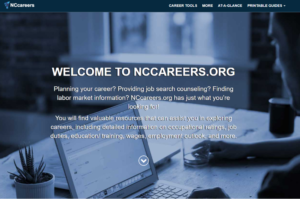The NGA Center for Best Practices, with support from the Siemens Foundation, is working with states through the Policy Academy on Scaling Work-Based Learning to scale high-quality work-based learning programs. North Carolina was involved in Phase II of the Academy, receiving technical assistance from NGA, and is now involved in Phase III as a mentor state to share best practices with new states.
Background
Work-based learning is an employer-driven workforce development strategy that aligns education with the needs of business. It provides participants with opportunities to learn about different industries and occupations through a continuum of experiences, ranging from career awareness to career training. Work-based learning benefits employers because they have a direct role in designing their future workforce’s training and skills-development to ensure they meet in-demand talent needs. Given this return on investment for participants and business, governors and their administrations are increasingly using their power to encourage the growth of high-quality work-based learning programs in their states.
In 2018, Governor Roy Cooper launched NC Job Ready, a workforce development initiative with the goal of increasing skills, educational attainment, and employer leadership in North Carolina. Governor Cooper sees a well-trained workforce as essential to strengthening existing companies, attracting new business, and building a strong state economy.
North Carolina Business Committee for Education (NCBCE), a business-led non-profit that operates out of the Office of the Governor, took on a leadership role during this effort. To build on NC Job Ready and to scale work-based learning across the state, NCBCE, in partnership with Fidelity Investments, launched The Navigator. The Navigator is a free online tool to help connect classroom instruction to hands-on career learning for educators and students across North Carolina. The platform also streamlines interactions among businesses, education, and workforce development communities to facilitate and inform the creation of new work-based learning programs and improve the quality of existing programs. The Navigator was developed as part of North Carolina’s efforts in the National Governors Association’s Policy Academy for Scaling Work-Based Learning (the Policy Academy). The Navigator helps employers participate in work-based learning by streamlining and simplifying the outreach process to fill work-based learning roles. Through The Navigator, employers post work-based learning opportunities (like job shadowing and internships) and educators, counselors and job coaches can search for and request those opportunities for their students.
The strategic process North Carolina went through to create The Navigator was successful not only in creating an online repository of resources but also in building critical buy-in from key stakeholders. Since launching in December 2018, The Navigator has successfully engaged 75,111 teachers representing every county and 392 businesses with 667 work-based learning opportunities to date. Every local education district is represented on the platform. Other states can learn from North Carolina’s process to better connect educators and employers to provide work-based learning opportunities to students.
Stakeholder Engagement and Creating Buy-In
An online platform such as The Navigator is only successful if a critical mass of stakeholders logs on and utilizes it. NCBCE recognized this during the beginning stages of planning for The Navigator and was strategic about how and when it engaged its key stakeholders: educators and employers. Before launching, NCBCE recognized the need to hear what educators and employers wanted out of an online work-based learning platform to make sure that The Navigator was filling a real and critical need. This also created natural buy-in and engagement from both groups.
First, in Summer 2017, NCBCE met with developers at Fidelity and employers already involved with NCBCE and workforce boards on the concept of The Navigator. NCBCE found that it was most successful to start with employers who were already familiar with proponents of work-based learning. Soon after talking with employers, NCBCE workshopped the idea with educators. Career development coordinators from across the state were involved throughout development, and the state career and technical education (CTE) director was also brought in at crucial junctures. Governor Cooper’s teacher advisory committee, made up of educators representing a variety of subject areas, was also consulted several times.
In a 21st century economy, we can make every day career day, and to succeed in connecting education to careers, putting employers and educators together to give students a real taste of the skills they need. The Navigator platform streamlines this connection and helps our students get real-world exposure that will help them chart the best educational path.”
Governor Roy Cooper
In July 2018, about six months before its official launch, NCBCE presented the concept of The Navigator at the NCCTE Summer Conference, the annual conference for North Carolina educators who are interested in CTE. This became an annual presentation and a successful way to reach a large audience, by speaking to over 130 people at one event. CTE educators became the biggest advocates for The Navigator and helped engage educators from different academic subjects. They see The Navigator as an important tool that connects their students to opportunities for career exploration and experience, while reducing teachers’ difficulties in finding such opportunities.
The Navigator launched in December of 2018 at NCBCE’s Experience More Summit on Work-Based Learning. For a year and a half after, NCBCE got feedback from a working group of educators to gather input on its functionality and how to make the tool more useful. The feedback typically focused on what information The Navigator gathered and led the creators to focus on more data collection in later iterations.
To continue outreach with employers, NCBCE went on a road show comprised of webinars and in-person presentations to advertise The Navigator at local chambers of commerce, local workforce boards, and with individual employers. To date, NCBCE has given over 125 presentations on the tool. Most participating employers are medium-sized companies, but about half are comprised of small businesses representing industries ranging from architecture firms, to contractors, to entrepreneurs. Corporate companies, such as banks and tech companies, already had training curriculum that easily adapted to work-based learning, and NCBCE leveraged this to incentivize their participation. Employers such as Dell Technology, BB&T, Lenovo, and the NC Court system are a sampling of the large employers posting resources on The Navigator.
NCBCE also worked with a communications firm to create a brand, Real World Learning for Real Life Success, which lead to the creation of the Experience More website, a home to work-based learning materials with a direct link to The Navigator.
Due to current limitations imposed by COVID-19, NCBCE plans to create pre-recorded videos to share virtually and to continue advertising The Navigator.
Data Collection

In exchange for receiving funding through the Carl D. Perkins Career and Technical Education Act (Perkins), a federal investment to advance and strengthen CTE programs, states must report uses of Perkins grant funding[1]. Measuring quality and quantity is essential to expanding high-quality work-based learning. Gathering data allows states to identify who is participating and where there are gaps across industries, geography, and participant demographics. Data collection has been an evolving component of The Navigator. The first version of The Navigator tracked which employers and educators utilized the tool and connected with each other, but nothing more. After feedback revealed an interest in increased data and tracking, The Navigator was updated to collect work-based learning opportunities, the number of districts that engage in work-based learning, teachers who looked at work-based learning resources, and the number of employers that engaged in work-based learning and which career clusters they are in. The Navigator also now connects with NCcareers.org, North Carolina’s online career exploration website that is used across state agencies.
The latest update to The Navigator will collect additional data from teachers, including which classes participate in work-based learning, gender and age of student participants, academic standards met through work-based learning, which employability skills are gained through work-based learning, and general feedback on the work-based learning experience. This version will also track CTE activities that use Perkins funding which saves the state time and administrative burden.
Expanding Rural Access

The Navigator’s ability to collect data helps assess gaps in work-based learning, including student and teacher participation, employer engagement, and resource variety. The Navigator also indicates which counties across the states are not engaged. NCBCE works diligently to provide opportunities in rural communities and for disconnected youth.
In response to COVID-19, The Navigator has acted as a tool to bridge gaps between rural and urban areas across the state. By moving online, students in rural and remote parts of the state have access to employers in other cities. Prior to COVID-19, there were three virtual work-based learning opportunities; now all work-based learning opportunities are set up as virtual, unless the employer has requested otherwise. Virtual opportunities include employer guest speakers and virtual job shadowing. NCBCE hopes that once employers see the value of virtual opportunities, they will continue to or increase their virtual offerings, thereby diversifying the offerings available to rural students.
Lessons Learned
Over two years, The Navigator has evolved as a platform and expanded work-based learning opportunities across the state. Pursuing a thoughtful and deliberate process for creation of a tool like this takes time but sets up the effort for success in the long run. Going forward, NCBCE plans to continue iterating the functionality of The Navigator and expanding its use by focusing on data collection and reporting and by engaging community colleges and workforce boards.
NCBCE and its partners have learned several practical lessons along the way, many of which emulate best practices that surfaced from the Academy.
Involve state leadership and connect your online platform to a broader workforce development vision.
- Recruit governors and other state leaders to act as public advocates for work-based learning and the online platform.
- Communicate how the online platform will help meet broader work-based learning and workforce development goals.
Engage stakeholders in regular conversations and implementation to collect feedback and make improvements.
- Engage educators, employers, and other necessary stakeholders (such as workforce development boards and community colleges) from the start to help create a platform that responds directly to their needs.
- Start creating support for the platform by communicating the value and return on investment of work-based learning.
- Engage with CTE educators and career development coordinators. They can be the biggest advocates for the tool and should inform its creation and improvement.
- Create a feedback loop to continuously improve the platform and respond to real-time needs of educators, employers, and students. Creating a system is not the final step; continuous engagement with stakeholders is critical for implementation and usability.
Collect and use data to measure, evaluate, and expand work-based learning.
- Include a data representativeto help inform data collection from the beginning. Educators depend on data collection for federal funding purposes, so this function will help gain their support.
- Use data to analyze gaps and opportunities for work-based learning expansion, particularly for regions and populations who are underrepresented.
- If considering collecting student data, house the tool in a public agency rather than a private or non-profit partner. This will reduce sharing burdens and security concerns.
Author
Kristin Baddour, Policy Analyst, NGA Center for Best Practices.
Learn more at: Scaling High-Quality Work-Based Learning













